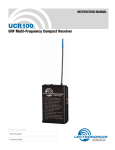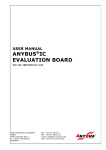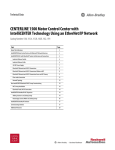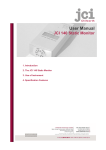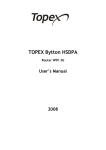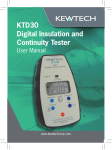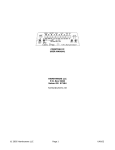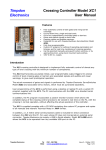Download User Manual - Static Direct
Transcript
Static Direct Limited, 74a The Broadway, Chesham, Buckinghamshire HP5 1EG Tel: +44 1494 792 177 Fax: +44 1494 794 201 E-mail: [email protected] Web: www.staticdirect.com User Manual for Static Monitor JCI 100 UM100 issue 30 October 2006 Contents: 1. Introduction 2. The JCI 100 Static Monitor 3. Use of instrument 4. CE Conformance 5. Specification features (Supply of all Static Direct products & services are subject to standard terms & conditions) Registered Number 4446650 Vat Registration Number 818257612 28/01/2007 Static Direct Limited, 74a The Broadway, Chesham, Buckinghamshire HP5 1EG Tel: +44 1494 792 177 Fax: +44 1494 794 201 E-mail: [email protected] Web: www.staticdirect.com USER MANUAL - JCI 100 STATIC MONITOR A compact instrument for easy, sensitive and reliable measurement and monitoring of electrostatic conditions 1. INTRODUCTION Static electricity causes problems in many areas of industry: • ignition of flammable gases • shocks to personnel • attraction of airborne dust and debris • cling of thin films and light fabrics • damage to semiconductor devices • upset of operation of microelectronic system operation Static electricity arises when materials in contact are separated and the speed of charge movement on either surface and away to earth is long compared to the time for the surfaces to move apart. Many operations in industry and normal life involve the contact and separation of materials that are poor or bad conductors of electricity - plastics are notable examples. Common examples are the occurrence of sparks when combing the hair or taking off an acrylic jumper, shocks when getting out of a car and shocks after walking across a nylon carpet and touching earthed conductors. The separation of such surfaces is often associated with retention of static charge. Voltages of several thousand volts (and up to 20KV) can be generated on our bodies as we go about normal daily activities. When we touch a metal object and feel a shock or, for example, when we hear a crackle as we take off an acrylic jumper we create an electrical discharge. This may give us a shock, damage a microelectronic circuit or couple into the computer and upset computer operation. Manufacturing operations may involve the handling of thin sheet materials - for instance in the printing and packaging industries. Static can cause sheets to stick together or be attracted to nearby surfaces. This attraction is a particular problem with lingerie that may tend to cling to the body. It will cause attraction of dust and debris from the air - so packages become 'dirty' when left on the Supermarket shelf. With powders (for instance in the pharmaceutical industry) material flow may be restricted. In flammable atmospheres static build up leading to the occurrence of sparks can cause explosions and fires - with the risk of loss of life and damage to plant and people. Controlling static: The secret is to prevent any major build-up of static on people, on industrial plant or on materials. This requires effective linking to 'earth'. With metal plant and equipment this means good and reliable earth bonding - links you can see and check. With many materials it is not so easy. Most plastics are bad conductors of electricity - i.e. charge does not move easily over or through the material. To enable such materials to dissipate static fairly quickly they need to have additives included in their manufacture or have surface treatment. Static charge needs to be able to leak away to earth over and through materials within a fraction of a second. (Supply of all Static Direct products & services are subject to standard terms & conditions) Registered Number 4446650 Vat Registration Number 818257612 28/01/2007 Static Direct Limited, 74a The Broadway, Chesham, Buckinghamshire HP5 1EG Tel: +44 1494 792 177 Fax: +44 1494 794 201 E-mail: [email protected] Web: www.staticdirect.com Role of measurements: How do you know if you have problems with static, how do you find the source and cause of problems, how do you know if remedial actions are effective and how do you choose appropriate material? The answer is measurements. 2. THE JCI 100 STATIC MONITOR The JCI 100 is a compact induction probe instrument to measure the voltage of surfaces at a distance. The voltage sensitivity is up to 20,000 volts full scale for 100mm (4") separation. Measurements are shown on a liquid crystal display with decimal point. For absolute measurements, the instrument would need to be switched on in a 'static free' environment because it is an 'induction probe' type instrument. Interpretation of the readings obtained with the JCI 100 needs to be approached with care. For instance, a charged plastic film lying on an earthed surface may show only a low surface voltage - but this (and the associated electrostatic energy) can increase dramatically when it is lifted up. The significance of readings depends very much on the practical situation and the type of risk or problem involved. The user needs to be aware of the need to assess the significance of readings appropriately. If in doubt it will be helpful to consult some of the Codes of Practice or Standards available, for example 'The control of undesirable static electricity' BS 5958: Part 1: 1991 and/or 'Methods for measurements in electrostatics' BS 7506: Part 1: 1995 Part 2: 1996. 3. USE OF INSTRUMENT 3.1 Getting started: By the time you read this User Manual you will already have opened the JCI 100 carrying case. Now take out the instrument. Hold the instrument in the hand with the liquid crystal display upward and the plate-sensing aperture away from the body. Take the earth bonding lead (yellow) out of the case and connect it to the 'earth bonding point' on the right hand side of the back of the instrument. Connect the other end of the lead to an earth point - using either the 'Durable Dot' connector or the crocodile clip. Now switch on the instrument. The ON/OFF switch on the front face is a press & hold switch. A piece of plastic (polythene bag, biro) rubbed and held in front of the sensing aperture will make the displayed numbers change - and give larger readings when closer. 3.2 Aspects of operational use: Earth bonding: The instrument needs to be bonded to earth via the bonding point on the back if the readings are to be meaningful. (Supply of all Static Direct products & services are subject to standard terms & conditions) Registered Number 4446650 Vat Registration Number 818257612 28/01/2007 Static Direct Limited, 74a The Broadway, Chesham, Buckinghamshire HP5 1EG Tel: +44 1494 792 177 Fax: +44 1494 794 201 E-mail: [email protected] Web: www.staticdirect.com Handheld operation: The instrument can be held by the side grooves with the display uppermost facing towards the operator. The hand should be towards the rear of the instrument to minimise the influence on sensitivity. Switch-on: The instrument is switched on by the press down switch on the front face. Flammable atmospheres: The JCI 100 instrument is Not Certified for use in areas where flammable gases are or may be present. Only BASEEFA or similarly Certified instruments should be used in such atmospheres. Care of instrument: JCI 100 instruments are designed to be easy to use in normal work areas. They will withstand normal handling but may be damaged if knocked or dropped. Care should be taken in use and storage to avoid dust, dirt or fluff entering the sensing apertures. This will impair operation - as shown by unstable readings and/or an appreciable shift of zero setting. It may be possible to remove dust or dirt with a fine brush or by blowing or using an aerosol spray cleaner. If the problem persists the instrument should be returned to the supplier for servicing. Low Battery: LO BATT indication on the display will start to flash when the battery voltage has fallen to about 7.3V. Performance will remain satisfactory for a time after this but the battery should be renewed for reliable operation. Batteries: JCI 100, JCI 140 and JCI145 instruments are operated by a 9V PP3 battery. Access to the battery compartment is achieved by turning the instrument over and sliding the battery compartment cover forward. Take the battery out and carefully remove the connector. The snap-on connector should be securely connected to the new battery before the battery is replaced and the cover slid closed. Batteries should not be left in the instrument for extended periods as any fluid leakage from an old battery could cause corrosion and damage. Over 4 hours continuous operation can be expected from a new PP3 battery. External power supply: JCI 140F instruments may be used with an external power supply for long-term continuous monitoring observations. The power supply required is 12V isolated from earth. Power may be supplied to the instrument either via the 8w mini DIN connector or via the 2.1mm d.c. power connector in the back cover. A 12V 250mA regulated supply e.g. from an isolated supply ‘wall cube’ (with centre positive) will be suitable. 4. CE CONFORMANCE The design and construction of these instruments (JCI 100) conform to the requirements of the EC Directive on Electromagnetic Compatibility (EMC) 89/336/EEC to Standards EN 50081-1:1992 and EN 50082-1: 1992. These instruments also conform to the requirements of the Electrical Equipment (Safety) Regulations 1994 (S.I. 1994/3260). (Supply of all Static Direct products & services are subject to standard terms & conditions) Registered Number 4446650 Vat Registration Number 818257612 28/01/2007 Static Direct Limited, 74a The Broadway, Chesham, Buckinghamshire HP5 1EG Tel: +44 1494 792 177 Fax: +44 1494 794 201 E-mail: [email protected] Web: www.staticdirect.com 5. SPECIFICATION FEATURES: Display: 3½ digit liquid crystal display of surface voltage in kilovolts at 100mm with polarity and 'LO BATT' indication Controls: Press on/off switch screwdriver zero adjustment (hole in base) Power supply: PP3 replaceable battery External power supply unit (12V 250mA floating from earth) via 2.1mm d.c. connector or via 8w mini DIN (+ve blue (6), –ve brown (8)) Earth bonding: Combination 10mm 'Durable Dot' and 4mm bayonet pin socket earth bonding point. Supplied with earth bonding cord. Dimensions: 34 x 66 x 149.5mm overall. Weight: 320g Calibration: JCI 100 instruments are set up in manufacture with measurements whose accuracy is traceable to NPL standards. Formal Calibration to BS 7506: Part 2: 1996 and Calibration Certificate extra. (Supply of all Static Direct products & services are subject to standard terms & conditions) Registered Number 4446650 Vat Registration Number 818257612 28/01/2007





